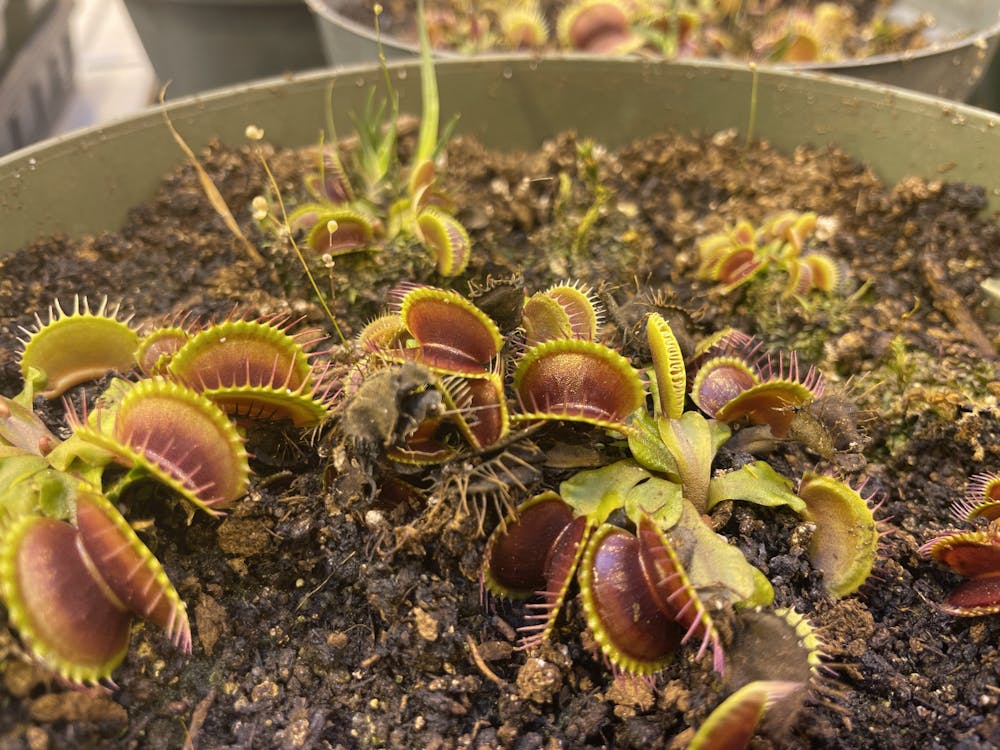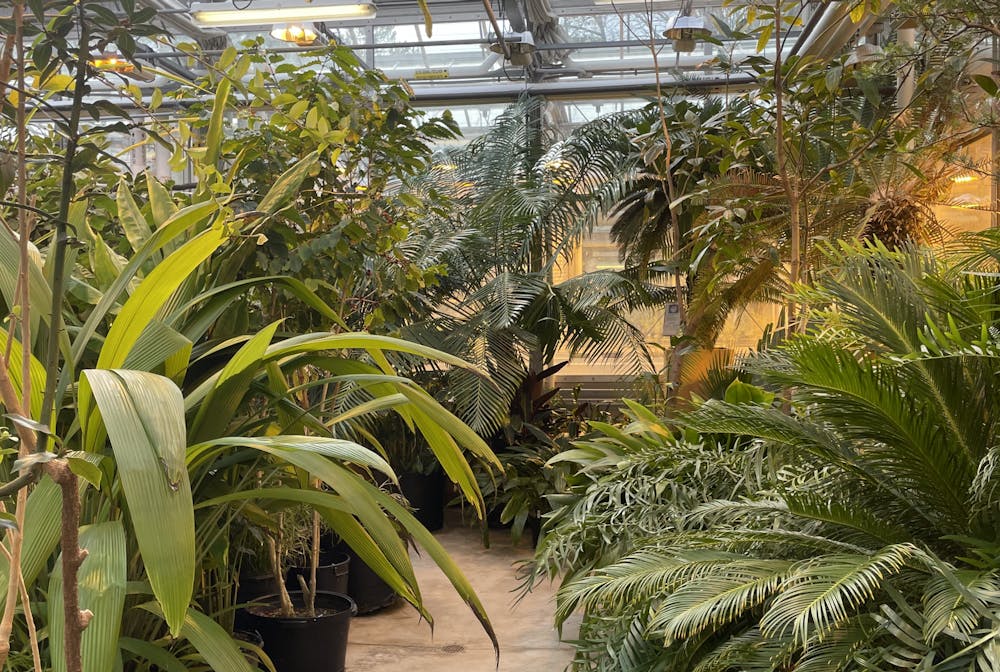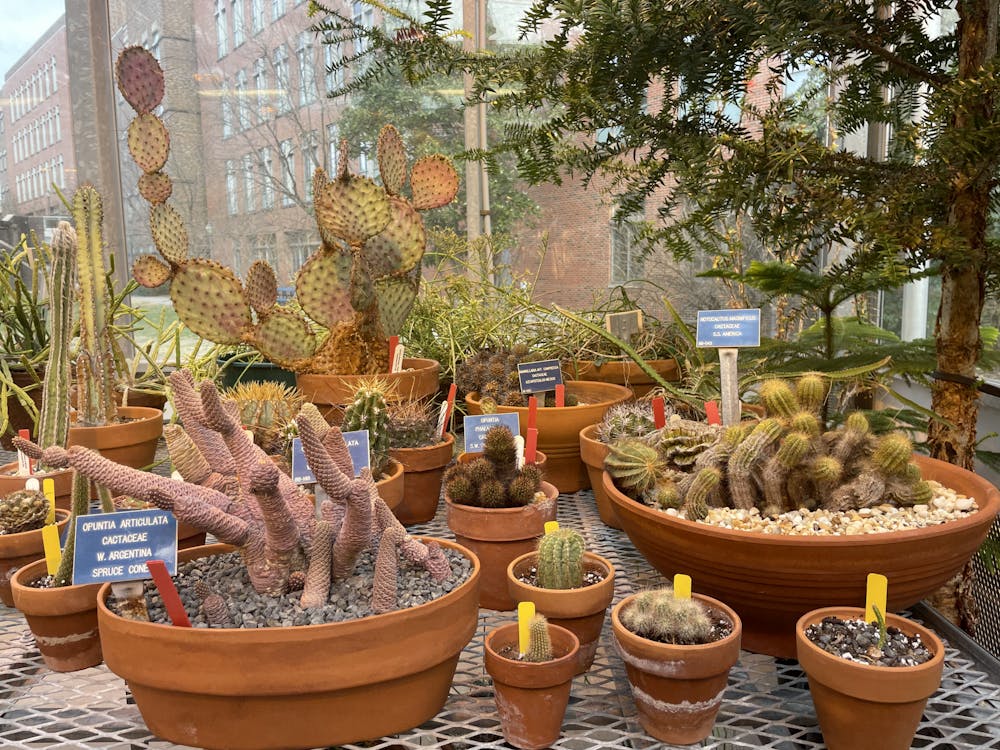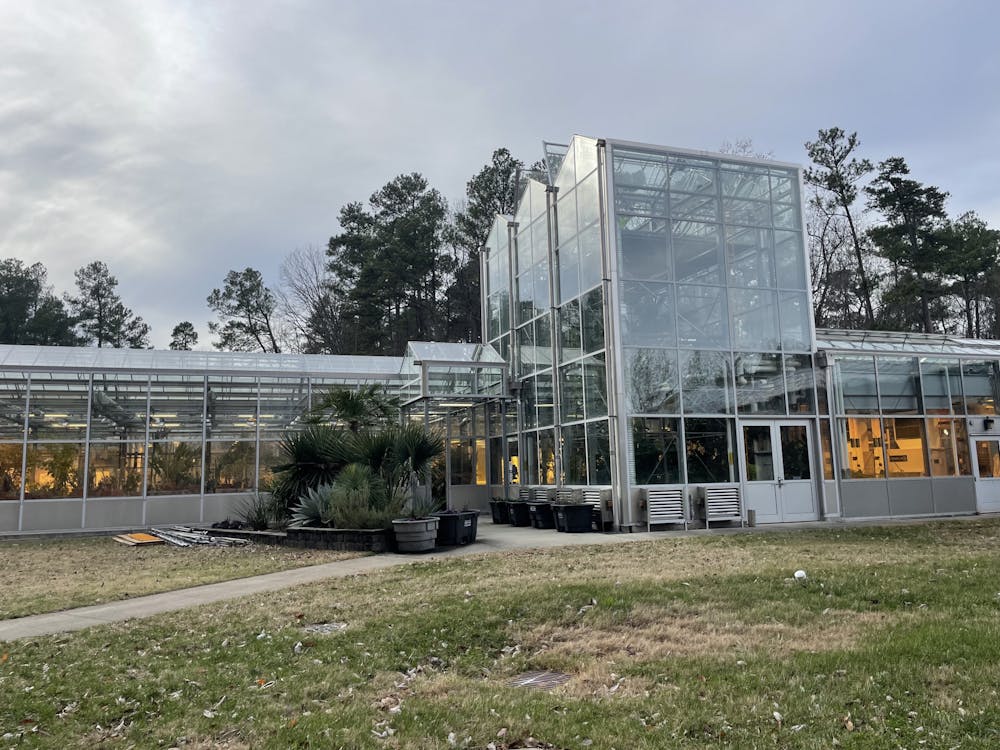Beneath the gray winter skies, a glass structure, half-obscured by the French Sciences Building, glows with a warm yellow light.
A tall metal door opens to reveal an unexpected oasis. Inside, everything is green and alive like the lush jungles of a distant land. Trees grow to the ceiling, leaves the size of umbrellas block the paths, and plants of all shapes and textures sit happily in their pots. The stresses of next week's exams and job interviews evaporate into serenity.
Built in 2004, the Duke Greenhouse spans over 15,000 square feet of indoor space, divided into live plant collection and research rooms.
Live plant collection started at the greenhouse as early as the late 1800s when faculty members returning from conducting research in other countries donated plants to the facility.
Assistant Horticulturist Kristin Dimac-Stohl explained that some plants have been in the collection since the 1960s, when the greenhouse was just a group of hoop houses. As the plant collection grew, Duke decided to build a more permanent facility to house them. While the greenhouse was being built, Duke community members pitched in to care for the plants in their homes.
Today, the greenhouse’s live plant collection contains over 800 species, including rare and endangered plants.

The collection is divided into four zones: carnivorous plants, the tropical zone, the xeric zone and the temperate zone. The carnivorous plants zone is home to plants such as Venus flytraps and pitcher plants. The tropical zone, which is hot and humid, houses plants like banana trees and coffee trees, while the xeric zone is hot and dry and is home to succulents and cacti. The temperate zone has moderate temperatures and humidity, with plants like Spanish moss and orchids.
Caring for the wide variety of plants in the greenhouse’s collection is an exciting challenge for Dimac-Stohl.
“I get to spend my day trying to figure out how better to care for these guys, how better to make them happy,” she said. “I really do consider each one of these [plants] unique, wonderful living things.”
Greenhouse staff provide year-round care for plants and perform daily maintenance like watering, fertilization and pest management.
Dimac-Stohl explained that, in the last two years, greenhouse staff have reduced pesticide use to protect the health of the plants and those who work with them. Instead, the staff uses beneficial insects which hunt the bugs that harm plants.

Due to its non-central location behind the French Family Science Center many people do not know that the greenhouse exists or how to take advantage of its resources, according to Dimac-Stohl.
“We’re kind of hidden back here,” she joked.
Greenhouse staff members give tours of the live plant collection to undergraduate courses and laboratories in the Duke Department of Biology department. The greenhouse also offers tours to students, parents and others by appointment. Dimac-Stohl hopes more people will take advantage of these tours.
“[Giving tours] is one of my favorite parts about my job because I get to bring people and plants together,” she said.
Get The Chronicle straight to your inbox
Sign up for our weekly newsletter. Cancel at any time.

While the live plant collection is used primarily for teaching, many graduate students use the greenhouse facilities to grow their plants.
Jonathan Colen, a doctoral candidate in biology who works in the Rausher lab, studies how flower traits impact their biological fitness. Although most of Colen’s work occurs in the field, he uses the greenhouse to grow plants from which he harvests seeds and plants them at another site.
Colen’s favorite part of working in the greenhouse is its calming atmosphere.
“It gives you a reprieve, especially when you’re doing a lot of lab work or in the winter months where it’s gray and gloomy outside,” he said. “To be able to go in and see these beautiful flowers and get to spend time … with nature and get to focus on the plants, to me there’s something kind of therapeutic.”
Izumi Osawa, assistant horticulturist in the greenhouse’s research area, believes another feature that makes the greenhouse special is its support for researchers pursuing various projects.
“The greenhouse is very flexible. If you see a project that you want to start at the greenhouse, you can probably do it,” Osawa said.
Amelia Lawrence, a doctoral candidate in biology in the Willis lab, has taken advantage of this flexibility to pursue a unique research project that involves using bees to pollinate plants.
“I have to cross thousands of plants, and I can’t do that by hand,” she explained. “I have a hive of bumble bees in [the greenhouse], and I will use them to pollinate for me.”
Lawrence is currently the only student beekeeper, but she hopes the program will expand in the future. Her favorite part of working in the greenhouse is the supportive staff, citing Greenhouse Supervisor Jorge Fidhel Gonzalez as the only reason she was able to do her experiment.

Gonzalez makes decisions about how to care for plants and maintain the greenhouse’s infrastructure. According to Gonzalez, greenhouse staff work year-round to care for the plants.
“When it’s raining or we have snow, someone has to come in and check in on the greenhouse and the plants. It’s 365-days’ work,” he said. “If [researchers] spent 10 years to do an investigation, you don’t want to lose all the investigation in one night.”
Aside from taking care of the plants, Gonzalez is currently managing renovations of air conditioning units, the roof of the tropical zone and other equipment upgrades. The renovations began in July 2022 and are expected to finish February 2023.
Despite his demanding workload, Gonzalez believes “plants and people” make working in the greenhouse worth it.
“The relationship between people and plants is the best,” he said. “People that work with plants are very open people, and they are very friendly. To work with plants you need some sensitivity.”

Zoe Spicer is a Trinity senior and an enterprise editor of The Chronicle's 120th volume.

